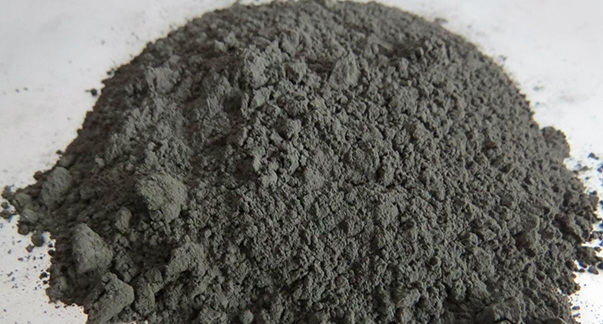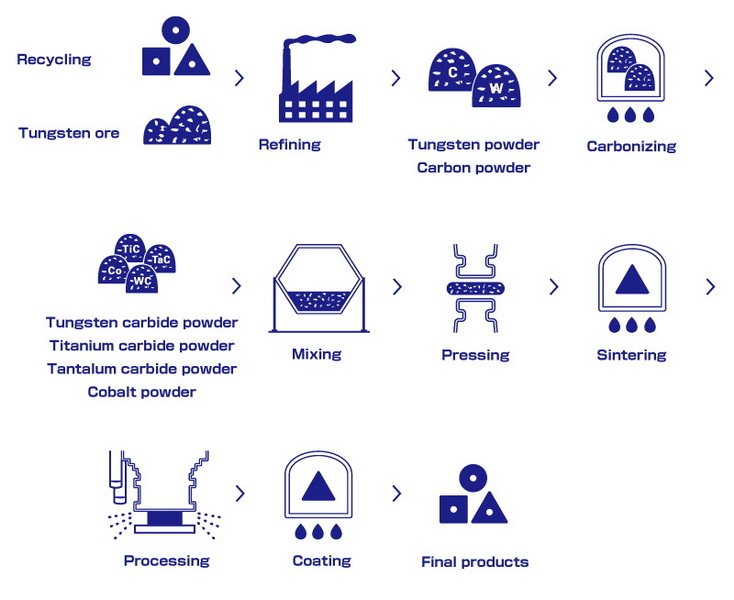Content Menu
● 1. Raw Material Preparation
>> 1.1 Tungsten Ore Processing
>> 1.2 Carbon Source Preparation
>> 1.3 Binder Preparation
● 2. Powder Mixing and Milling
>> 2.1 Ball Milling
>> 2.2 Spray Drying
● 3. Pressing (Forming)
>> 3.1 Uniaxial Pressing
>> 3.2 Cold Isostatic Pressing (CIP)
● 4. Sintering
>> 4.1 Pre-Sintering
>> 4.2 Liquid-Phase Sintering
>> 4.3 Hot Isostatic Pressing (HIP)
● 5. Post-Sintering Processing
>> 5.1 Grinding and Polishing
>> 5.2 Coating (Physical Vapor Deposition/Chemical Vapor Deposition)
>> 5.3 Quality Control
● 6. Applications of Carbide Products
>> 6.1 Cutting Tools
>> 6.2 Mining & Construction
>> 6.3 Industrial Wear Parts
>> 6.4 Emerging Applications
● Conclusion
● FAQ: Carbide Production Process
>> 1. Why is cobalt used as a binder in carbide?
>> 2. Can carbide products be recycled?
>> 3. How do grain sizes affect carbide performance?
>> 4. Why is sintering critical in carbide manufacturing?
>> 5. What industries rely most on carbide tools?
● Citations:
Carbide production combines advanced metallurgy, precision engineering, and material science to create one of humanity's hardest industrial materials. This article explores the intricate steps behind manufacturing tungsten carbide, a critical material for cutting tools, mining equipment, and wear-resistant components.

1. Raw Material Preparation
The carbide production process begins with sourcing and refining raw materials:
1.1 Tungsten Ore Processing
Tungsten ore (typically wolframite or scheelite) is mined through open-pit or underground methods. Major deposits exist in China, Russia, and Canada.
Chemical leaching with sodium hydroxide or hydrochloric acid extracts tungsten trioxide (WO₃) with 99.9% purity.
The oxide undergoes hydrogen reduction in rotary furnaces at 600–1,000°C to produce pure tungsten powder (W).
1.2 Carbon Source Preparation
High-purity carbon black (99.95% C) or synthetic graphite is added to achieve the stoichiometric ratio for tungsten carbide (WC). Excess carbon (0.1–0.5%) compensates for oxidation losses.
1.3 Binder Preparation
Cobalt powder (6–30% by weight) is prepared as the primary binder. Nickel or chromium may supplement specific grades for corrosion resistance.
Binder particle sizes (0.8–3 µm) are optimized to ensure even distribution during mixing.
2. Powder Mixing and Milling
Uniform distribution of components ensures consistent material properties:
2.1 Ball Milling
Tungsten powder, carbon, and cobalt are mixed in a ball mill with ethanol or acetone to prevent oxidation.
Zirconia or tungsten carbide balls grind the slurry for 24–72 hours, reducing particles to 0.5–5 µm.
Laser diffraction analyzers monitor particle size distribution (PSD) to meet ISO 4497 standards.
2.2 Spray Drying
The slurry is atomized in a spray dryer at 200–300°C, forming spherical granules (50–200 µm) with 1–3% residual moisture.
Free-flowing granules ensure uniform die filling during pressing.
3. Pressing (Forming)
Powder is compacted into "green" shapes with 50–70% theoretical density:
3.1 Uniaxial Pressing
Automated CNC presses apply 30,000–60,000 psi pressure to form near-net shapes like inserts or rods.
Lubricants (e.g., stearic acid) reduce die wall friction, minimizing density gradients.
3.2 Cold Isostatic Pressing (CIP)
For complex geometries (e.g., helical drill flutes), CIP uses hydraulic oil at 30,000–60,000 psi to ensure uniform density.
Elastomeric molds allow intricate designs while maintaining ±0.1 mm dimensional accuracy.
4. Sintering
The green compacts undergo high-temperature consolidation to achieve full density:
4.1 Pre-Sintering
Parts are heated to 500–800°C in hydrogen atmospheres to remove organic binders and strengthen handling.
Pre-sintered parts retain 70–80% porosity but gain enough strength for intermediate machining.
4.2 Liquid-Phase Sintering
Vacuum or hydrogen furnaces heat parts to 1,400–1,500°C for 60–180 minutes.
Cobalt melts at 1,495°C, infiltrating tungsten carbide particles via capillary action to form a dense matrix.
Shrinkage of 17–25% occurs, requiring oversizing during pressing.
4.3 Hot Isostatic Pressing (HIP)
Optional HIP treatment at 1,400°C and 30,000 psi argon pressure eliminates residual porosity (<0.02%).
HIP-ed parts exhibit 10–20% higher transverse rupture strength (TRS) than conventionally sintered ones.
5. Post-Sintering Processing
Final machining and treatments enhance performance:
5.1 Grinding and Polishing
Diamond wheels (80–400 grit) grind inserts to Ra 0.1–0.4 µm surface finishes.
CNC grinding machines achieve ±0.005 mm tolerances for cutting edges.
5.2 Coating (Physical Vapor Deposition/Chemical Vapor Deposition)
PVD coatings (TiN, TiAlN) at 300–500°C provide 2–4 µm layers with 3,500 HV hardness.
CVD coatings (diamond-like carbon) at 800–1,000°C offer extreme wear resistance for mining tools.
5.3 Quality Control
X-ray fluorescence (XRF) verifies cobalt content within ±0.5%.
Rockwell A scale (HRA) tests confirm hardness values of 88–94.
Transverse rupture strength (TRS) tests ensure 2,500–4,500 MPa fracture resistance.

6. Applications of Carbide Products
6.1 Cutting Tools
Indexable inserts (ISO CNMG/SNMG) machine steel at 300–500 m/min speeds.
Micro-grain carbide (0.2 µm) end mills produce optical-grade finishes on aerospace alloys.
6.2 Mining & Construction
Tri-cone drill bits with carbide inserts penetrate granite at 30–50 meters/hour.
Road milling teeth reclaim asphalt with 200+ operating hours between replacements.
6.3 Industrial Wear Parts
Tungsten carbide seals withstand 500°C abrasive slurries in petrochemical pumps.
Valve trim components resist cavitation erosion in nuclear power plants.
6.4 Emerging Applications
Additive manufacturing uses nano-carbide powders (50–100 nm) for 3D-printed rocket nozzles.
Biomedical implants leverage carbide's biocompatibility in joint replacements.
Conclusion
The carbide production process transforms raw tungsten and carbon into a material rivaling diamond in hardness. From powder metallurgy to precision grinding, each step ensures the final product meets rigorous industrial demands. Innovations like HIP sintering, nano-structured carbides, and hybrid coatings continue to expand applications in aerospace, renewable energy, and advanced manufacturing. With global carbide demand projected to grow 6.2% annually through 2030, mastering these production techniques remains critical for industrial competitiveness.

FAQ: Carbide Production Process
1. Why is cobalt used as a binder in carbide?
Cobalt's ductility balances tungsten carbide's brittleness, enhancing toughness without compromising hardness. Its melting point (1,495°C) aligns perfectly with liquid-phase sintering requirements.
2. Can carbide products be recycled?
Yes, scrap carbide is reclaimed through zinc recovery (90% efficiency) or mechanical crushing. Recycled material constitutes 35% of global tungsten supply.
3. How do grain sizes affect carbide performance?
Finer grains (0.2–0.8 µm) increase hardness (up to 2,300 HV30), while coarser grains (1–5 µm) improve fracture resistance (TRS >4,000 MPa).
4. Why is sintering critical in carbide manufacturing?
Sintering densifies the material to 99.5% theoretical density, achieving Vickers hardness of 1,500–2,000 HV. Improper sintering causes catastrophic defects like cobalt pooling.
5. What industries rely most on carbide tools?
Aerospace (40% market share), automotive (25%), and oil/gas (20%) industries use carbide for high-speed machining, drill bits, and wear plates.
Citations:
[1] https://www.youtube.com/watch?v=zJkVi0cmtX0
[2] https://onmytoolings.com/how-are-carbide-inserts-made/
[3] https://www.hannibalcarbide.com/technical-support/about-carbide/
[4] https://www.mmc-carbide.com/in/technical_information/tec_guide/tec_guide_carbide
[5] https://www.retopz.com/57-frequently-asked-questions-faqs-about-tungsten-carbide/
[6] https://www.carbide-products.com/blog/tungsten-carbide-production-process/
[7] https://www.betalentcarbide.com/production-process-of-cemented-carbide-blade.html
[8] https://www.carbide-products.com/blog/how-is-carbide-made/
[9] https://www.linkedin.com/pulse/tungstencarbide-production-process-tungsten-carbide-shijin-lei
[10] https://www.zgcccarbide.com/news/The-Manufacturing-Process-of-Cemented-Carbide-Inserts:-A-Comprehensive-Guide-39.html
[11] https://www.youtube.com/watch?v=95yS7W66-BI
[12] https://www.allied-material.co.jp/en/techinfo/tungsten_carbide/process.html
[13] https://todaysmachiningworld.com/magazine/how-it-works-making-tungsten-carbide-cutting-tools/
[14] https://www.shutterstock.com/search/production-carbide?image_type=photo&page=3
[15] https://www.istockphoto.com/photos/carbide-tools
[16] https://www.alamy.com/stock-photo/calcium-carbide.html
[17] https://www.shutterstock.com/search/production-carbide?image_type=photo&page=2
[18] https://stock.adobe.com/search/images?k=carbide+cutting
[19] https://imechanica.org/files/BASIC%20MANUFACTURING%20PROCESSES%20Questions%20and%20answers%2007%20JuLY%202013.pdf
[20] https://tuncomfg.com/about/faq/
[21] https://testbook.com/question-answer/________process-is-used-for-making-a-complic--6253c8b58a09ec2605fdd5af
[22] https://www.tjtywh.com/a-step-by-step-guide-to-making-calcium-carbide-at-home.html
[23] https://patents.google.com/patent/US4008090A/en
[24] https://www.youtube.com/watch?v=olAlOs0Er00
[25] https://www.istockphoto.com/photos/calcium-carbide
[26] https://www.istockphoto.com/photos/carbide-bit
[27] https://www.freepik.com/premium-ai-image/flowchart-illustrating-steps-involved-production-tungsten-carbide-tools-using-powder_362617291.htm
[28] https://www.istockphoto.com/photos/carbide
[29] https://www.shutterstock.com/search/carbide
[30] https://www.tungco.com/insights/blog/frequently-asked-questions-used-tungsten-carbide-inserts/
















